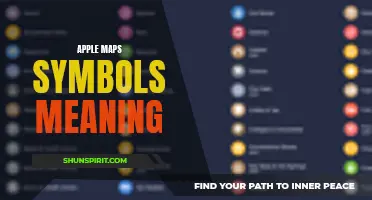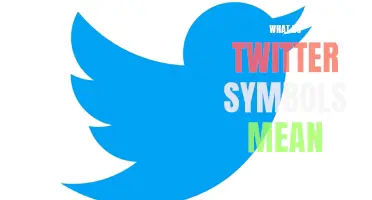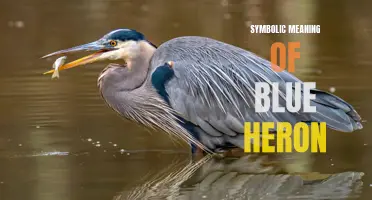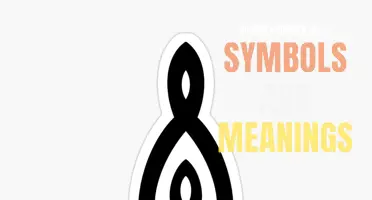
Tarot cards have long fascinated and intrigued people with their rich and complex symbolism. Each card in the deck is adorned with intricate images that convey a deeper meaning, capturing the essence of the human experience and providing insights into our past, present, and future. From the fool's journey to the hierophant's wisdom, these symbols hold hidden truths, offering guidance and inspiration in our quest for self-discovery. Whether you believe in their mystical powers or appreciate their psychological symbolism, the tarot cards' symbol meanings invite us to explore the depths of our own consciousness and uncover the mysteries that lie within.
What You'll Learn
- What are some common symbols found on tarot cards and what do they typically represent?
- How do different tarot decks differ in their symbolic meanings?
- Are tarot card symbols universally understood, or do they have different interpretations in different cultures?
- How do readers use symbol meanings to interpret tarot card spreads?
- Can the same symbol have different meanings depending on its position in a tarot card spread?

What are some common symbols found on tarot cards and what do they typically represent?
Tarot cards are a popular tool used for divination and self-reflection. They are used to gain insight into various aspects of life such as love, career, and personal growth. Each tarot card is adorned with a multitude of symbols that hold deep meaning and significance. These symbols are rich in history and can be traced back to various cultures and belief systems. In this article, we will explore some common symbols found on tarot cards and their typical interpretations.
The Fool: The Fool is a key card in the tarot deck and often represents new beginnings, spontaneity, and a willingness to take risks. The symbol of a white dog represents loyalty and the possibility of being guided by one's instincts. The cliff that the Fool is about to step off signifies faith and a leap of faith into the unknown.
The Magician: The Magician is a card that symbolizes personal power, manifestation, and the ability to actualize one's desires. The symbol of the infinity sign above the magician's head represents limitless potential and the four suits on the table signify the ability to utilize the four elements to manifest one's goals.
The High Priestess: The High Priestess is a card that represents intuition, mystery, and inner wisdom. The crescent moon at her feet symbolizes feminine power and the connection to the cycles of the moon. The scroll she holds represents hidden knowledge and the veil behind her conveys the idea of secrets and mysteries yet to be revealed.
The Empress: The Empress is a card that embodies femininity, abundance, and creativity. The symbol of the crown of twelve stars represents the twelve zodiac signs and signifies the Empress's connection to the celestial realm. The wheat she holds in her hand symbolizes fertility and growth, while the heart-shaped shield represents love and nurturing.
The Emperor: The Emperor is a card that symbolizes authority, stability, and rationality. The symbol of the ram's head on his throne represents assertiveness and leadership. The scepter he holds represents power and control, while the globe beneath his feet signifies his dominion over the material world.
The Hierophant: The Hierophant is a card that represents tradition, spirituality, and conformity. The two pillars behind him symbolize the dualities of life, and the crossed keys represent the keys to knowledge and unlocking mysteries. The triple crown on his head signifies his connection to the divine and his role as a spiritual teacher.
These are just a few examples of the symbols found on tarot cards and their typical interpretations. It is worth noting that the meanings of these symbols can vary depending on the specific tarot deck being used and the individual reader's interpretation. Tarot cards are a deeply personal tool and can offer unique insights to each person who engages with them. Understanding and interpreting the symbols on the cards is an essential part of unlocking the wisdom and guidance they have to offer.
Rock Symbolism: Exploring the Meaning of Rocks in Different Cultures
You may want to see also

How do different tarot decks differ in their symbolic meanings?
Tarot cards have been used for centuries as a tool for divination and gaining insight into the past, present, and future. There are hundreds of different tarot decks available today, each with its own unique artistic style and symbolic meanings. While the basic structure of the cards remains the same, the symbols and imagery used in each deck can vary greatly.
One of the most influential decks in the history of tarot is the Rider-Waite-Smith deck, created by artist Pamela Colman Smith and published in 1910. This deck set the standard for many subsequent decks and is still widely used today. The images in the Rider-Waite-Smith deck are rich in symbolism, with each card depicting a scene that can be interpreted in various ways. For example, the Fool card shows a young man about to step off a cliff, symbolizing new beginnings and taking risks. The Empress card depicts a nurturing figure surrounded by symbols of fertility, representing abundance and growth.
Other popular tarot decks include the Crowley-Harris Thoth deck, created by Aleister Crowley and Lady Frieda Harris, and the Marseille tarot deck, which has been in use since the 16th century. These decks differ from the Rider-Waite-Smith deck in their use of symbolism and imagery. The Thoth deck, for example, incorporates elements of astrology, alchemy, and Egyptian mythology into its cards. Each card in this deck is rich in symbolism, allowing for deep insights and complex interpretations.
In contrast, the Marseille tarot deck has a more simplistic and traditional style. It uses simple line drawings and vibrant colors to depict the various cards. The symbolism in this deck is often more subtle and relies on the viewer's intuition and understanding of traditional tarot meanings. The Marseille deck is known for its straightforward readings and emphasis on the fundamental meanings of the cards.
There are also many modern decks that take a more contemporary approach to tarot symbolism. These decks often feature non-traditional imagery and incorporate elements from popular culture, mythology, or personal experiences. Some modern decks use abstract or surrealistic artwork to convey the meaning of the cards. These decks can be a refreshing and unique way to connect with the tarot, offering new insights and perspectives on the traditional meanings of the cards.
It's important to note that while the symbolism in each deck may differ, the core meanings of the tarot cards remain the same. The Major Arcana cards, for example, represent major life events and spiritual lessons, regardless of the deck they are depicted in. The Minor Arcana cards, on the other hand, represent everyday situations and events. The suits of the Minor Arcana cards may vary from deck to deck (e.g., cups, swords, wands, or pentacles), but their overall meanings remain consistent.
Ultimately, the choice of tarot deck will depend on personal preference and individual interpretation. Some people may resonate more with the traditional symbolism of the Rider-Waite-Smith deck, while others may prefer the depth and complexity of the Thoth deck. It's important to find a deck that speaks to you and allows you to connect with the cards in a meaningful way. Exploring different tarot decks can be a fascinating journey of self-discovery and spiritual exploration, offering new insights and perspectives with each deck encountered.
The Symbolic Death Meaning: Understanding the Deeper Significance Behind the Final Transition
You may want to see also

Are tarot card symbols universally understood, or do they have different interpretations in different cultures?
Tarot cards are a popular form of divination that has been used for centuries to gain insights into the past, present, and future. Each card in a standard tarot deck is adorned with symbolic images, which are believed to hold hidden meanings and messages. But are these tarot card symbols universally understood, or do they have different interpretations in different cultures?
The origins of tarot cards can be traced back to the 15th century in Europe, specifically Italy and France. Over time, the tarot deck has evolved and expanded, with various schools of thought and interpretations emerging. While there are certain symbols and themes that are consistent across different decks, the interpretations of these symbols can vary depending on the culture and tradition in which they are being used.
For example, the Rider-Waite-Smith tarot deck, which is one of the most widely used and recognized decks, features a number of symbols that are often associated with positive or negative meanings in Western cultures. The sun, for instance, is typically seen as a symbol of warmth, vitality, and success. In contrast, the moon is often associated with mystery, intuition, and the unconscious mind. These interpretations are deeply rooted in Western symbolism and mythology.
However, if we were to look at tarot card symbols from a different cultural perspective, we may find different interpretations altogether. In Chinese culture, for example, the sun is often seen as a symbol of vitality and good fortune, while the moon represents yin energy, darkness, and femininity. Similarly, in Indian culture, the sun is associated with the god Surya and is seen as a powerful symbol of divine light and enlightenment.
The interpretation of tarot card symbols can also vary within the same culture or tradition. Different tarot readers may have different interpretations based on their personal beliefs, experiences, and understanding of the cards. Some readers may rely heavily on traditional interpretations, while others may incorporate their own intuitive insights or spiritual beliefs into their readings.
It is important to note that while there may be different interpretations of tarot card symbols, the overall purpose and function of tarot cards remain the same across cultures. Tarot cards are used as tools for self-reflection, guidance, and personal growth. The symbolism in tarot cards serves as a catalyst for intuition and insight, allowing individuals to tap into their own subconscious and higher consciousness.
In conclusion, tarot card symbols can have different interpretations in different cultures, as well as within the same culture. The meanings associated with these symbols are often deeply rooted in cultural, mythological, and spiritual beliefs. However, regardless of the specific interpretations, tarot cards serve as a powerful tool for self-reflection and personal growth. Ultimately, it is up to the individual to connect with the symbols and find their own personal understanding and meaning within the cards.
The Symbolic Meaning of Rain: A Deep Dive into its Significance
You may want to see also

How do readers use symbol meanings to interpret tarot card spreads?
Tarot cards are often used as a tool for divination and self-reflection. Each card in a tarot deck has a unique symbol or image, and these symbols are believed to hold specific meanings. When interpreting a tarot card spread, readers rely on these symbol meanings to gain insight into the question or situation at hand.
The symbols on tarot cards can be interpreted in different ways, depending on the reader's knowledge, intuition, and personal experiences. Some readers rely on the traditional meanings associated with each symbol, while others may interpret the symbols based on their own understanding and connection to the cards. Regardless of the approach, symbol meanings play a significant role in the interpretation of tarot card spreads.
One way readers use symbol meanings is by analyzing the individual cards in a spread. Each card has its own symbolism, which can provide insight into various aspects of the question or situation being asked. For example, the High Priestess card often represents intuition, mystery, and the unconscious mind. When this card appears in a spread, the reader may interpret it as a sign that the querent should trust their intuition or explore their inner thoughts and desires. By understanding the symbol meanings associated with each card, readers can provide more accurate and insightful interpretations.
Readers also consider the placement of the cards in a spread when interpreting symbol meanings. The position of a card within a spread can influence its meaning or indicate its role in the overall message. For instance, a card in the past position may represent past experiences or influences that have shaped the current situation, while a card in the future position may represent potential outcomes or upcoming events. By considering the symbol meanings of each card in relation to its position, readers can provide a more nuanced and tailored interpretation.
In addition to individual card meanings and placement, readers also look for patterns and connections between the cards in a spread. This is known as reading the cards in context. For example, if multiple cards with similar symbol meanings appear in a spread, it may suggest a recurring theme or message. Similarly, the interaction between cards can provide additional layers of meaning. For instance, if a card with a positive symbol meaning appears next to a card with a negative symbol meaning, it may suggest a conflict or tension within the situation. By exploring these patterns and connections, readers can offer a deeper understanding of the message conveyed by the tarot card spread.
Ultimately, readers use symbol meanings to unlock the messages and insights hidden within tarot card spreads. By understanding the symbols and their associated meanings, readers can provide guidance, clarity, and perspective to those seeking answers or guidance. Whether relying on tradition or intuition, the interpretation of symbol meanings is a fundamental aspect of tarot card reading and a powerful tool for self-reflection and divination.
The Spiritual Significance: Exploring Hindu Symbol Tattoos and Their Meanings
You may want to see also

Can the same symbol have different meanings depending on its position in a tarot card spread?
The symbolism of tarot cards is a complex and multifaceted subject. Each card in the deck is rich with symbolism and meaning, and the way these symbols interact with each other can greatly influence their interpretation. However, it is important to note that the meanings of tarot cards are not set in stone and can vary depending on the reader and the context in which they are drawn.
In a tarot card spread, the position of a card can play a significant role in its interpretation. Different tarot spreads have their own unique layouts, and the position of a card within the spread can add nuance and depth to its meaning.
For example, let's say you have drawn the Fool card in a three-card spread, with the positions representing past, present, and future. In the past position, the Fool may represent a sense of innocence and naivety that has led to past mistakes or missed opportunities. In the present position, it may suggest a need to embrace a playful and spontaneous approach to life. In the future position, it could indicate a new beginning or a leap of faith that will bring about positive change.
In this example, the Fool card retains its core symbolism of new beginnings, risks, and a sense of adventure, but its interpretation varies depending on its position within the spread. The same can be true for other cards in the deck, where their meanings can be influenced by their position or the cards surrounding them.
It is also worth noting that the interpretation of tarot cards can be highly subjective. Different readers may have their own personal associations and interpretations for each card and its position, based on their own experiences, knowledge, and intuition. The same card can have different meanings for different readers, even within the same position in a tarot card spread.
Ultimately, tarot card reading is a deeply personal practice, and the interpretation of the cards is a fusion of the reader's intuition and the symbolism of the cards themselves. In this way, the same symbol can indeed have different meanings depending on its position in a tarot card spread, as the context and interaction between cards can greatly influence their interpretation.
Decoding the Meaning Behind Keith Haring's Iconic Symbols
You may want to see also
Frequently asked questions
The ace of cups is a very positive card that represents love, emotions, and new beginnings in tarot card readings. It often symbolizes emotional fulfillment, deep connections, and the potential for great happiness in relationships.
The emperor card is a symbol of authority, stability, and control in tarot readings. It often represents a strong male figure, someone who is a leader and is focused on order and structure. This card can also signify the need to set boundaries and establish a sense of power and authority in one's own life.
Contrary to popular belief, the death card does not represent literal death in tarot readings. Instead, it symbolizes transformation and the end of a particular phase in one's life. It often signifies the need to let go of old patterns, beliefs, or relationships in order to make way for something new and transformative. The death card can also represent rebirth and the opportunity for growth and renewal.
The four of pentacles is a card that symbolizes stability, security, and material possessions in tarot readings. It often represents a desire to hold on tightly to what one has, whether it be money, possessions, or even relationships. This card can also suggest a fear of change or letting go, and may indicate the need for flexibility and openness in order to experience true abundance and prosperity.







